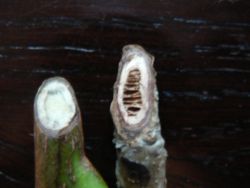Halifax Media Co-op
News from Nova Scotia's Grassroots
Hardy Walnuts of Nova Scotia
A lot of people are surprised to hear that we can grow many varieties of nuts here in Nova Scotia, including Chestnuts, Almonds, Hazels, Walnuts, pine nuts and some pecans as well as more exotic varieties like yellowhorn and gingko. Bill and Elizabeth Glen of PEI have been growing hazelnuts commercially since 2013, pioneering both a local market and best practices for Maritime nut growing.
We should be investing in planting perennial crops anyway, and trees in particular. Planting trees fixes carbon, mitigating climate change. And nut tree crops have the added benefit from a resilience standpoint of producing a harvest for 200-500 years, meaning they can be an asset well into the future in case of many potential scenarios of food scarcity. Walnut hulls and bark are useful as mulch, medicine and as a natural dye. Some people plant walnut as a retirement fund for one's grandchildren. Country Wisdom and know-how's Woodlot Management by Jay Heinrich writes that "A single huge flawless walnut tree can sell for several thousand dollars (one such tree reportedly brought 30'000 on the stump)".
The Sex life of nuts
If you want to obtain nuts from your trees it is is important to plant nuts that are compatible, that will pollinate each other. Nut trees finish putting out male flowers before starting to put out female flowers, and so often can't pollinate themselves. Trees must be from two different seedlings to be able to pollinate each other. Some nut trees will self-pollinate but even these will fruit better with a friend. If that fails, you can pick off male flowers, keep pollen in the freezer for a week or two and then throw them at the trees.
Identifying Hardy Walnuts
Heartnut
A Japanese variety with huge 6' leaves and heart-shaped nuts. There is a heartnut outside of St Mary's University.
Black Walnut and Butternut
The two species hailing from North America. Butternuts are endemic to the St John River valley. Black walnuts are extremely hardy and tasty but hard to get into or extract meaty bits. The black walnut can be identified by leaf scars that look like three line segments of half-circles like a monkey face or clover leaf with some imagination. This way they can be identified in winter.
As you can see here, the butternut monkey face has eyebrows
Buartnut Juglans x bixbyi
The unfortunately-named first generation of children between a heartnut and butternut. Buartnuts have heartnut's easy crackability and blight resistance while having butternut cold-hardiness.
Persian/English Walnuts
The grocery-store variety we are used to seeing, the English or Persian, is not yet quite hardy to our winters. Two exceptions are Carpathian and the totally safe for work Manregion, which will live in our zone 6. Some will survive even zone 4 which endures winter temperatures of -30 and includes such regions as Calgary.
Starting nut trees from seed
Credit to Sylvia Mangalam for teaching me to start nuts in pots buried in the ground in the fall, after they are thoroughly cleaned. In the spring, check the nuts for sprouted roots out the bottom, and of those that are sprouting, cut the main root tip to encourage surface side-branching roots. Then pot them back up and keep in dappled or part shade for a year or two before final planting in full sun. Time to first harvest varies from seedling to seedling and different variety grafts, but you can expect nuts after 5 to 10 years.
Planning for centuries
An urban legend has been going around of the foresters of Oxford University in England who set oaks aside for 300, 600 or 800 years until the ceiling beams of the main hall got too "beetly" and needed to be replaced. The tale grew in the telling it seems, and it's not true (though the trees were several hundred years old at harvest) but it's an appropriate sentiment.
I think it's high time to at least supplement our instant gratification with some long-term gratification. What were you doing five years ago? Starting school? Worrying about whether your pants are tight enough without being "too" tight? Convinced you would never grow a beard? The time went by faster than you thought. Trees move us beyond the treadmill of the next apartment, or the next election. They destroy the capitalist illusion of the perpetual present., connecting us to the gifts of our ancestors, and our responsibility to our descendents.
A fun article about ways to get into the shell and extract the delicious reward within
An exhaustive guide to growing nuts in Ontario
Walnuts secrete a substance called juglone that kills some plants that would grow underneath. Here is a guide to some resistant plants compatible with walnuts.
A good forager never reveals her secret stash, but I'm going to go ahead and say there are black walnuts growing behind the Dal Sportsplex. Now go nuts.
The site for the Halifax local of The Media Co-op has been archived and will no longer be updated. Please visit the main Media Co-op website to learn more about the organization.




